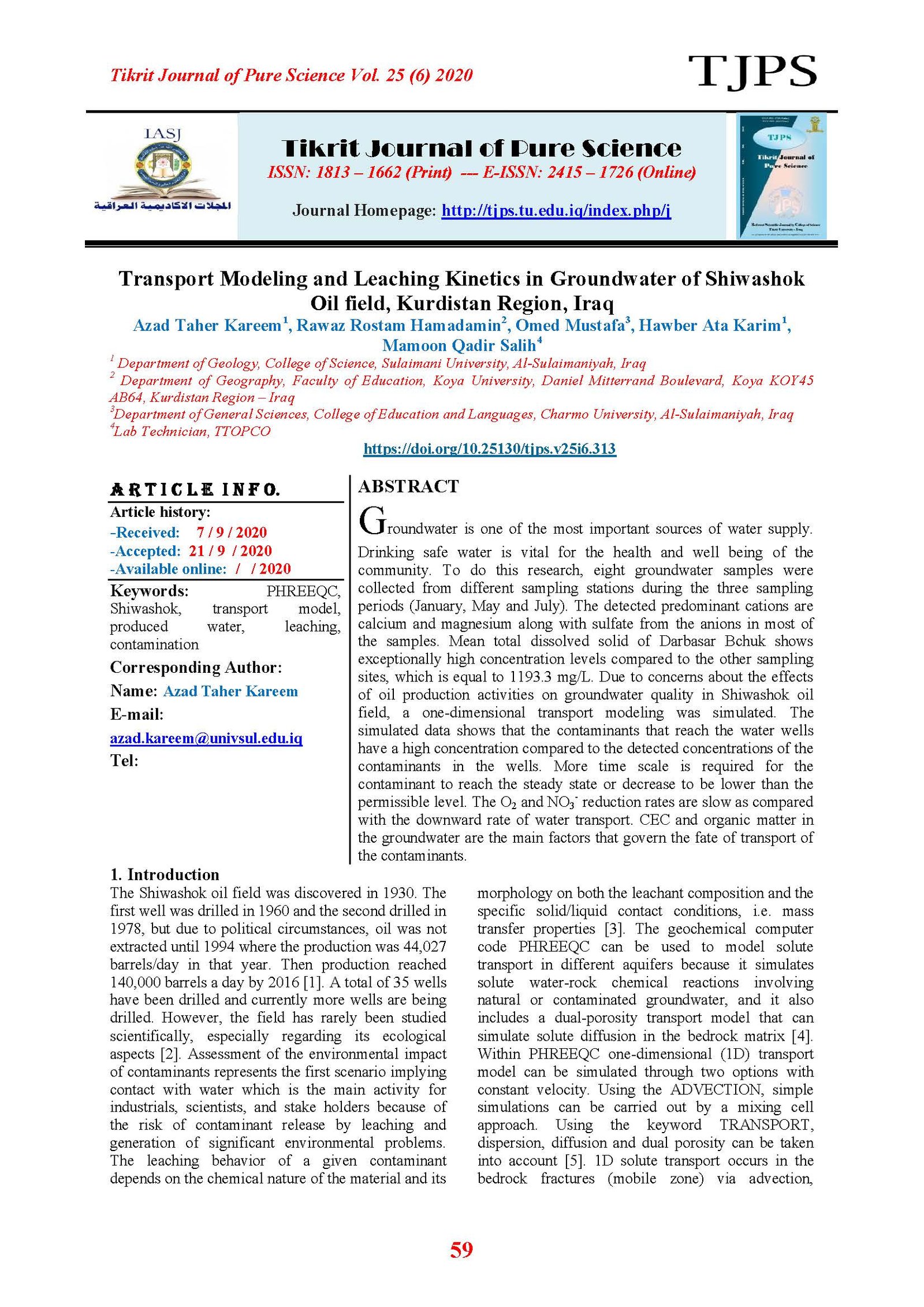Transport Modeling and Leaching Kinetics in Groundwater of Shiwashok Oil field, Kurdistan Region, Iraq
Main Article Content
Abstract
Groundwater is one of the most important sources of water supply. Drinking safe water is vital for the health and well being of the community. To do this research, eight groundwater samples were collected from different sampling stations during the three sampling periods (January, May and July). The detected predominant cations are calcium and magnesium along with sulfate from the anions in most of the samples. Mean total dissolved solid of Darbasar Bchuk shows exceptionally high concentration levels compared to the other sampling sites, which is equal to 1193.3 mg/L. Due to concerns about the effects of oil production activities on groundwater quality in Shiwashok oil field, a one-dimensional transport modeling was simulated. The simulated data shows that the contaminants that reach the water wells have a high concentration compared to the detected concentrations of the contaminants in the wells. More time scale is required for the contaminant to reach the steady state or decrease to be lower than the permissible level. The O2 and NO3- reduction rates are slow as compared with the downward rate of water transport. CEC and organic matter in the groundwater are the main factors that govern the fate of transport of the contaminants.
Article Details

This work is licensed under a Creative Commons Attribution 4.0 International License.
Tikrit Journal of Pure Science is licensed under the Creative Commons Attribution 4.0 International License, which allows users to copy, create extracts, abstracts, and new works from the article, alter and revise the article, and make commercial use of the article (including reuse and/or resale of the article by commercial entities), provided the user gives appropriate credit (with a link to the formal publication through the relevant DOI), provides a link to the license, indicates if changes were made, and the licensor is not represented as endorsing the use made of the work. The authors hold the copyright for their published work on the Tikrit J. Pure Sci. website, while Tikrit J. Pure Sci. is responsible for appreciate citation of their work, which is released under CC-BY-4.0, enabling the unrestricted use, distribution, and reproduction of an article in any medium, provided that the original work is properly cited.
References
[1] Ali, A., Hamad, N., Hamadamin, R. (2018). Assessment of the physical and chemical properties of groundwater resources in the Shewashok oil field”. Koya University Journal, 45: 163-183.
[2] Salih, M., Hamadamin, R., Aziz, R. (2019). Environmental Impacts of Shewashok Oil Field on Sheep and Cow Meat Using Vital Trace Elements as Contamination Bioindicators. UHD Journal of Science and Technology, 3(1): 1-8.
[3] Tiruta-Barna, L. (2008). Using PHREEQC for modelling and simulation of dynamic leaching tests and scenarios. Journal of Hazardous Materials, 157: 525–533.
[4] Lipson, D., McCray, J., Thyne, G. (2007). Using PHREEQC to Simulate Solute Transport in Fractured Bedrock. Ground Water, 45(4): 468–472.
[5] Merkel, B. and Planer-Friedrich, B. (2008). Groundwater Geochemistry. 2nd ed., Springer-Verlag Berlin Heidelberg: 230 pp.
[6] Jassim, Saad Z, and Jeremy C Goff. 2006. Geology of Iraq: DOLIN, sro, distributed by Geological Society of London.
[7] FAO. 2003. "Agro-ecological zoning of the three northern governorates of Iraq." FAO Agricultural Rehabilitation Programme. Plant production SS, Erbil, Iraq 12 (3):131-140.
[8] APHA 1998. Standard methods for the examination of water and wastewater, 20th ed. American Public Health Association, Washington
[9] Butler, J., Steiniger, D., Robarge, T., Phillips, E. (2010). Combining Hardware, Software, and Chromatography to Improve the GC/MS Analysis of Semi-Volatile Compounds. Thermo Fisher Scientific, Austin, TX, USA.
[10] Morgan, P., Lewis, S. T., & Watkinson, R. J. (1993). Biodegradation of benzene, toluene, ethylbenzene and xylenes in gas-condensate-contaminated ground-water. Environmental Pollution, 82(2), 181–190.
[11] Miotliński, K. (2008). Coupled Reactive Transport Modeling of Redox Processes in a Nitrate-Polluted Sandy Aquifer. Aquatic Geochemistry, 14(2), 117–131.
[12] Francisca, F.M., Carro Perez, M.E., Glatstein, D.A., Montoro, M.A., 2012. Contaminant transport and fluid flow in soils. In: Veress, B., Szigethy, J. (Eds.), Horizons in Earth Research. Nova Science Publishers, New York, pp. 179e214.
[13] Pintilie, S., Brânză, L., Beţianu, P., Vasile, L., Ungureanu, F., Gavrilescu M. (2007). Modeling and Simulation of Heavy Metals Transport in Water and Sediments. Environmental Engineering and Management Journal. Vol. 6, No. 2, 153-161.
[14] Pettenati, M., Perrin, J., Pauwels, H., & Ahmed, S. (2013). Simulating fluoride evolution in groundwater using a reactive multicomponent transient transport model: Application to a crystalline aquifer of Southern India. Applied Geochemistry, 29, 102–116.
[15] Appelo, C. A. J., & de Vet, W. W. J. M. (2003). Modeling in situ iron removal from groundwater with trace elements such as As. Arsenic in Ground Water, 381–401.
[16] Postma, D., Kjller, C., Sgaard Andersen, M., Condesso de Melo, M. T., & Gaus, I. (n.d.). Geochemical Modelling of Processes Controlling Baseline Compositions of Groundwater. Natural Groundwater Quality, 71–90.
[17] Sam, K., Coulon, F., & Prpich, G. (2016). Working towards an integrated land contamination management framework for Nigeria. Science of The Total Environment, 571, 916–925.
[18] Sam, K., & Zabbey, N. (2018). Contaminated land and wetland remediation in Nigeria: Opportunities for sustainable livelihood creation. Science of The Total Environment, 639, 1560–1573.
[19] Medjor, W. O., Akpoveta, V. O., & Adebowale, M. E. (2018). Remediation of hydrocarbons contaminated groundwater by silica encapsulation technique. Water-Energy Nexus, 1(2), 134–141.
